Heating Rate Effect on Gas Permeability and Pore Structure of Mortar under High Temperature
Abstract
:1. Introduction
2. Experimental Procedure
2.1. Materials and Specimens
2.2. Testing Program
2.2.1. Mass Loss Rate
2.2.2. Measurements of the Gas Permeability and Porosity
2.2.3. Microstructural Analysis
2.3. Determining Fractal Dimension from NMR
3. Results and Discussion
3.1. Effect of Heating Rate on Mass Loss
3.2. Effect of Heating Rate on Gas Permeability and Porosity
3.2.1. Initial Gas Permeability and Initial Porosity
3.2.2. Effect of Confinement on Gas Permeability and Porosity
3.3. Pore Structure of Mortar
3.3.1. Image Analysis
3.3.2. NMR T2 Spectra and Fractal Analysis
4. Conclusions
- (1)
- The initial gas permeability increased by two orders of magnitude and the initial porosity increased by 1.77 times in the mortar after it heated compared with the reference group (60 °C). The higher the target temperature the faster the heating rate has a greater effect on the gas permeability and porosity (i.e., heating at 15 °C/min to 600 °C). The microstructure analysis showed that the variations contribute to an increase in pore size and microcrack generation.
- (2)
- The gas permeability measurement under varying confining pressure displays a different behavior during the loading and unloading phase. All heated mortar showed significant pore volume reduction, which is not recovered after unloading due to the creation of microcracks at the sand/cement paste interface by heat treatment. These microcracks had varying width and tortuosity; therefore, they provide more gas passage at low confinement, and partially closed irreversibly at higher confining pressure. Compared with porosity, gas permeability is more sensitive to confining pressure, and the irreversibility of porosity confirms the irreversible closure of cracks and irreversible collapse of pores during the loading and unloading phase.
- (3)
- Thermal treatment at elevated temperatures may change the microstructure of mortar. The results obtained from SEM showed more micro gaps and microcracks in the mortar with the increased temperatures and heating rates. It confirmed the increase in connectivity of pore and microcrack with increasing temperature.
- (4)
- NMR relaxation is an efficient tool for non-destructively and quantitatively evaluating the pore structure of cement-based materials. Based on NMR experiment data, there is a slight decrease in the fractal dimension of pore volume with the increased temperatures and heating rates. Fractal dimensions calculated from the T2 spectrum show negative correlation relationships with the gas permeability and porosity.
Author Contributions
Funding
Data Availability Statement
Acknowledgments
Conflicts of Interest
References
- Struble, L.; Garboczi, E.; Clifton, J. Durability of High-Performance Cement-Based Materials. MRS Online Proc. Libr. 1991, 245, 329–340. [Google Scholar] [CrossRef]
- Carriço, A.; Real, S.; Bogas, J.A. Durability performance of thermoactivated recycled cement concrete. Cem. Concr. Compos. 2021, 124, 104270. [Google Scholar] [CrossRef]
- Carriço, A.; Real, S.; Bogas, J.A.; Pereira, M.F.C. Mortars with thermo activated recycled cement: Fresh and mechanical characterisation. Constr. Build. Mater. 2020, 256, 119502. [Google Scholar] [CrossRef]
- Li, Q.; Wang, M.; Sun, H.; Yu, G. Effect of heating rate on the free expansion deformation of concrete during the heating process. J. Build. Eng. 2021, 34, 101896. [Google Scholar] [CrossRef]
- Jiang, Z.-L.; Pan, Y.-J.; Lu, J.-F.; Wang, Y.-C. Pore structure characterization of cement paste by different experimental methods and its influence on permeability evaluation. Cem. Concr. Res. 2022, 159, 106892. [Google Scholar] [CrossRef]
- Shi, J.; Qian, R.; Wang, D.; Liu, Z.; Chun, Q.; Zhang, Y. Experimental study on gas petrmeability of cement-based materials. Cem. Concr. Compos. 2022, 129, 104491. [Google Scholar] [CrossRef]
- Li, K.; Xu, L.; Stroeven, P.; Shi, C. Water permeability of unsaturated cementitious materials: A review. Constr. Build. Mater. 2021, 302, 124168. [Google Scholar] [CrossRef]
- Chen, W.; Liu, J.; Brue, F.; Skoczylas, F.; Davy, C.A.; Bourbon, X.; Talandier, J. Water retention and gas relative permeability of two industrial concretes. Cem. Concr. Res. 2012, 42, 1001–1013. [Google Scholar] [CrossRef]
- Chen, W.; Han, Y.; Agostini, F.; Skoczylas, F.; Corbeel, D. Permeability of a Macro-Cracked Concrete Effect of Confining Pressure and Modelling. Materials 2021, 14, 862. [Google Scholar] [CrossRef]
- Gupta, S.; Kua, H.W.; Pang, S.D. Effect of biochar on mechanical and permeability properties of concrete exposed to elevated temperature. Constr. Build. Mater. 2020, 234, 117338. [Google Scholar] [CrossRef]
- Shen, J.; Xu, Q. Effect of elevated temperatures on compressive strength of concrete. Constr. Build. Mater. 2019, 229, 116846. [Google Scholar] [CrossRef]
- Chen, X.-t.; Caratini, G.; Davy, C.A.; Troadec, D.; Skoczylas, F. Coupled transport and poro-mechanical properties of a heat-treated mortar under confinement. Cem. Concr. Res. 2013, 49, 10–20. [Google Scholar] [CrossRef]
- Chadli, M.; Tebbal, N.; Mellas, M. Impact of elevated temperatures on the behavior and microstructure of reactive powder concrete. Constr. Build. Mater. 2021, 300, 124031. [Google Scholar] [CrossRef]
- Xue, W.; Shen, L.; Jing, W.; Li, H. Permeability evolution and mechanism of thermally damaged basalt fiber-reinforced concrete under effective stress. Constr. Build. Mater. 2020, 251, 119077. [Google Scholar] [CrossRef]
- Pei, Y.; Agostini, F.; Skoczylas, F. The effects of high temperature heating on the gas permeability and porosity of a cementitious material. Cem. Concr. Res. 2017, 95, 141–151. [Google Scholar] [CrossRef]
- Zhao, Y.; Ding, D.; Bi, J.; Wang, C.; Liu, P. Experimental study on mechanical properties of precast cracked concrete under different cooling methods. Constr. Build. Mater. 2021, 301, 124141. [Google Scholar] [CrossRef]
- Kim, K.Y.; Yun, T.S.; Park, K.P. Evaluation of pore structures and cracking in cement paste exposed to elevated temperatures by X-ray computed tomography. Cem. Concr. Res. 2013, 50, 34–40. [Google Scholar] [CrossRef]
- Ye, B.; Cheng, Z.; Ni, X. Effects of multiple heating-cooling cycles on the permeability and microstructure of a mortar. Constr. Build. Mater. 2018, 176, 156–164. [Google Scholar] [CrossRef]
- Ge, X.; Fang, K.; Zeng, L.; Chen, X. Properties of leakage corrosion of concrete and its durability. J. Wuhan Univ. Technol.-Mater Sci. Ed. 2008, 23, 946–949. [Google Scholar] [CrossRef]
- Jiang, L.; Guan, Y. Pore structure and its effect on strength of high-volume fly ash paste. Cem. Concr. Res. 1999, 29, 631–633. [Google Scholar] [CrossRef]
- Kumar, R.; Bhattacharjee, B. Porosity, pore size distribution and in situ strength of concrete. Cem. Concr. Res. 2003, 33, 155–164. [Google Scholar] [CrossRef]
- Zeng, Q.; Li, K.; Fen-Chong, T.; Dangla, P. Pore structure of cement pastes through NAD and MIP analysis. Adv. Cem. Res. 2016, 28, 23–32. [Google Scholar] [CrossRef]
- Yang, J.; Zeng, J.; He, X.; Zhang, Y.; Su, Y.; Tan, H. Sustainable clinker-free solid waste binder produced from wet-ground granulated blast-furnace slag, phosphogypsum and carbide slag. Constr. Build. Mater. 2022, 330, 127218. [Google Scholar] [CrossRef]
- Wang, Y.; Diamond, S. A fractal study of the fracture surfaces of cement pastes and mortars using a stereoscopic SEM method. Cem. Concr. Res. 2001, 31, 1385–1392. [Google Scholar] [CrossRef]
- Wang, L.; Xiao, L.; Yue, W. NMR Characterization of Pore Structure and Connectivity for Nano-self-assembly γ-Al2O3 and Precursor. Appl. Magn. Reson. 2018, 49, 1099–1118. [Google Scholar] [CrossRef]
- Ji, Y.; Sun, Z.; Yang, X.; Li, C.; Tang, X. Assessment and mechanism study of bleeding process in cement paste by 1H low-field NMR. Constr. Build. Mater. 2015, 100, 255–261. [Google Scholar] [CrossRef]
- Zhang, J.; Guo, J.; Li, D.; Zhang, Y.; Bian, F.; Fang, Z. The influence of admixture on chloride time-varying diffusivity and microstructure of concrete by low-field NMR. Ocean Eng. 2017, 142, 94–101. [Google Scholar] [CrossRef]
- Tziotziou, M.; Karakosta, E.; Karatasios, I.; Diamantopoulos, G.; Sapalidis, A.; Fardis, M.; Maravelaki-Kalaitzaki, P.; Papavassiliou, G.; Kilikoglou, V. Application of 1H NMR to hydration and porosity studies of lime–pozzolan mixtures. Microporous Mesoporous Mater. 2011, 139, 16–24. [Google Scholar] [CrossRef]
- Zhou, C.; Ren, F.; Zeng, Q.; Xiao, L.; Wang, W. Pore-size resolved water vapor adsorption kinetics of white cement mortars as viewed from proton NMR relaxation. Cem. Concr. Res. 2018, 105, 31–43. [Google Scholar] [CrossRef]
- Winslow, D.N. The fractal nature of the surface of cement paste. Cem. Concr. Res. 1985, 15, 817–824. [Google Scholar] [CrossRef]
- Gao, Y.; Gu, Y.; Mu, S.; Jiang, J.; Liu, J. The multifractal property of heterogeneous microstructure in cement paste. Fractals 2021, 29, 2140006. [Google Scholar] [CrossRef]
- Tang, S.W.; He, Z.; Cai, X.H.; Cai, R.J.; Zhou, W.; Li, Z.J.; Shao, H.Y.; Wu, T.; Chen, E. Volume and surface fractal dimensions of pore structure by NAD and LT-DSC in calcium sulfoaluminate cement pastes. Constr. Build. Mater. 2017, 143, 395–418. [Google Scholar] [CrossRef]
- Zhang, L.; Zhou, J. Fractal characteristics of pore structure of hardened cement paste prepared by pressurized compact molding. Constr. Build. Mater. 2020, 259, 119856. [Google Scholar] [CrossRef]
- Zeng, Q.; Luo, M.; Pang, X.; Li, L.; Li, K. Surface fractal dimension: An indicator to characterize the microstructure of cement-based porous materials. Appl. Surf. Sci. 2013, 282, 302–307. [Google Scholar] [CrossRef]
- Yu, P.; Duan, Y.H.; Chen, E.; Tang, S.W.; Wang, X.R. Microstructure-based fractal models for heat and mass transport properties of cement paste. Int. J. Heat Mass Transf. 2018, 126, 432–447. [Google Scholar] [CrossRef]
- Tang, S.; Wang, Y.; Geng, Z.; Xu, X.; Yu, W.; A, H.; Chen, J. Structure, Fractality, Mechanics and Durability of Calcium Silicate Hydrates. Fractal Fract. 2021, 5, 47. [Google Scholar] [CrossRef]
- Jin, S.; Zhang, J.; Han, S. Fractal analysis of relation between strength and pore structure of hardened mortar. Constr. Build. Mater. 2017, 135, 1–7. [Google Scholar] [CrossRef]
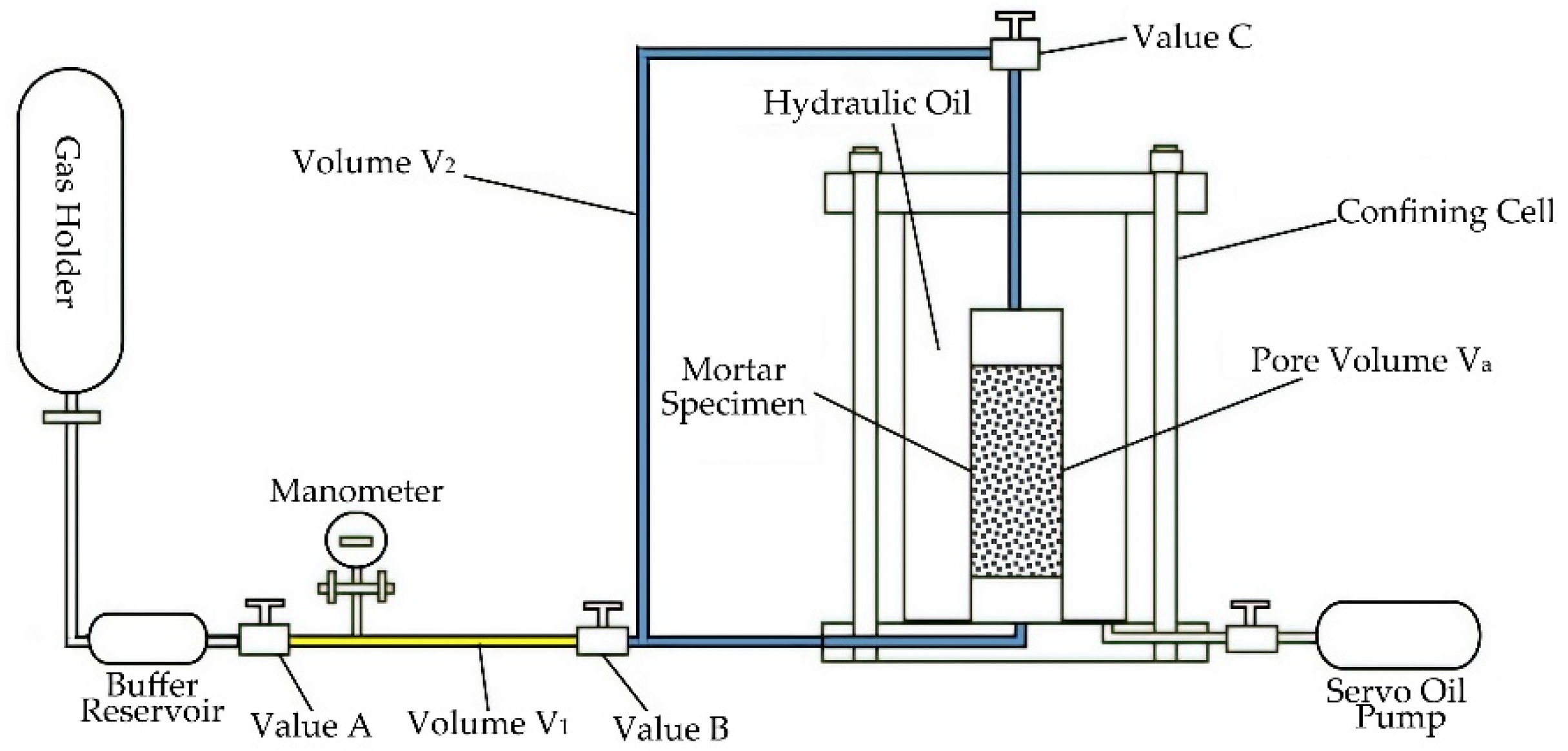
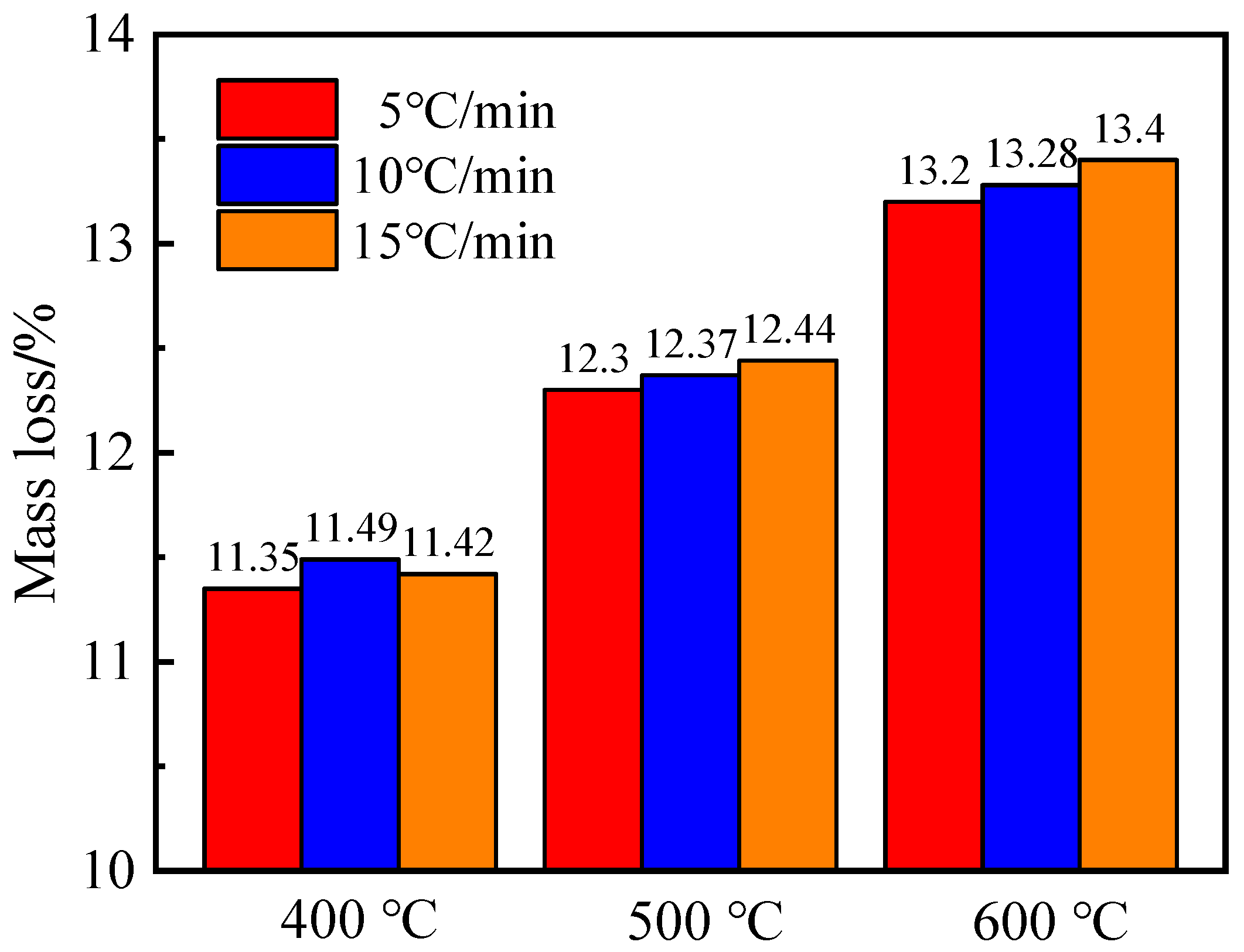

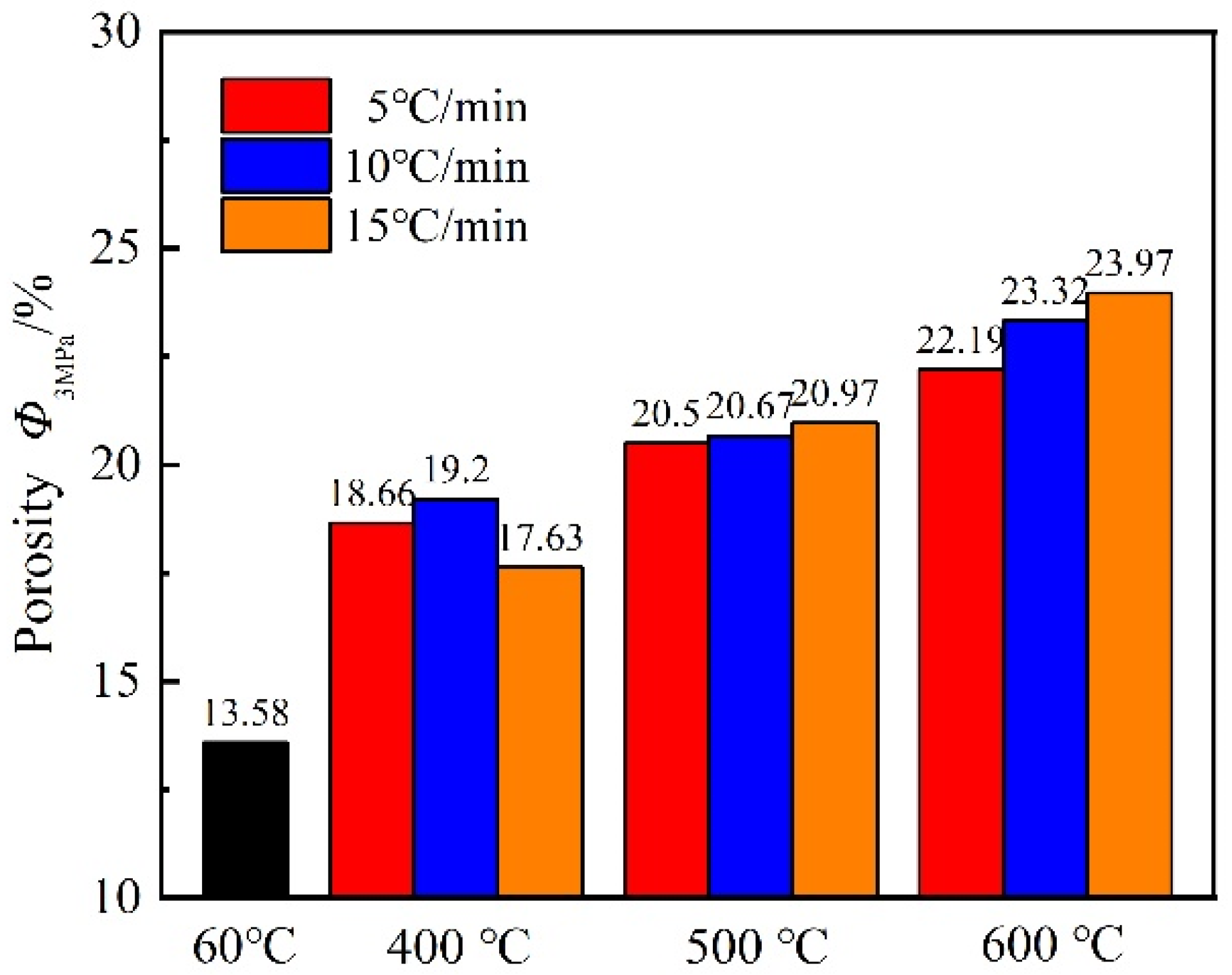
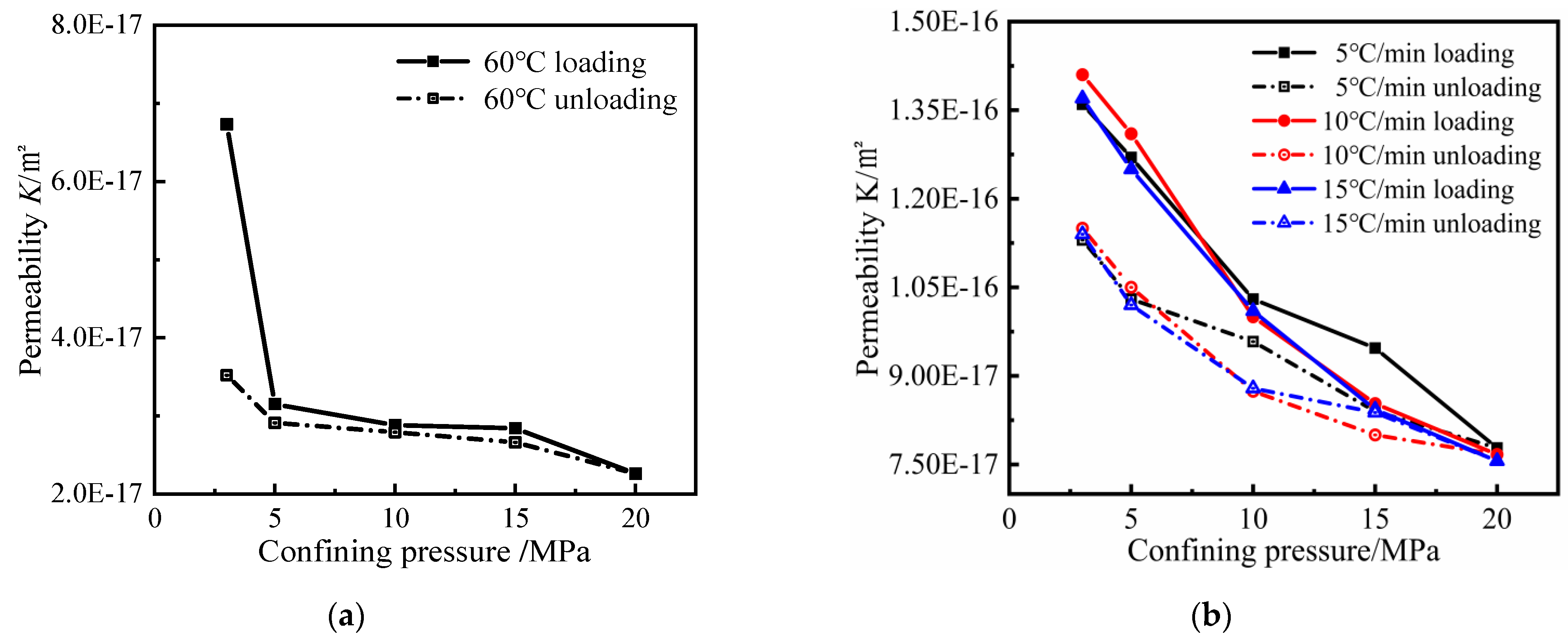
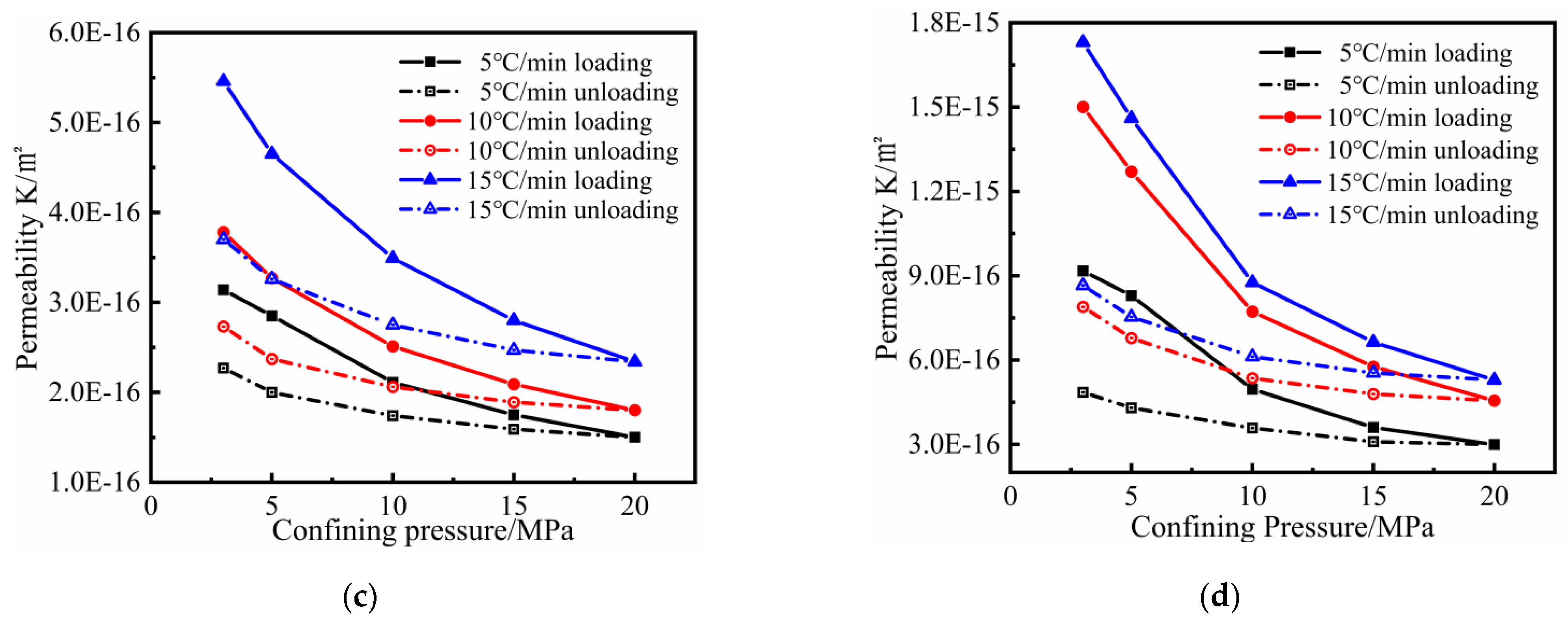
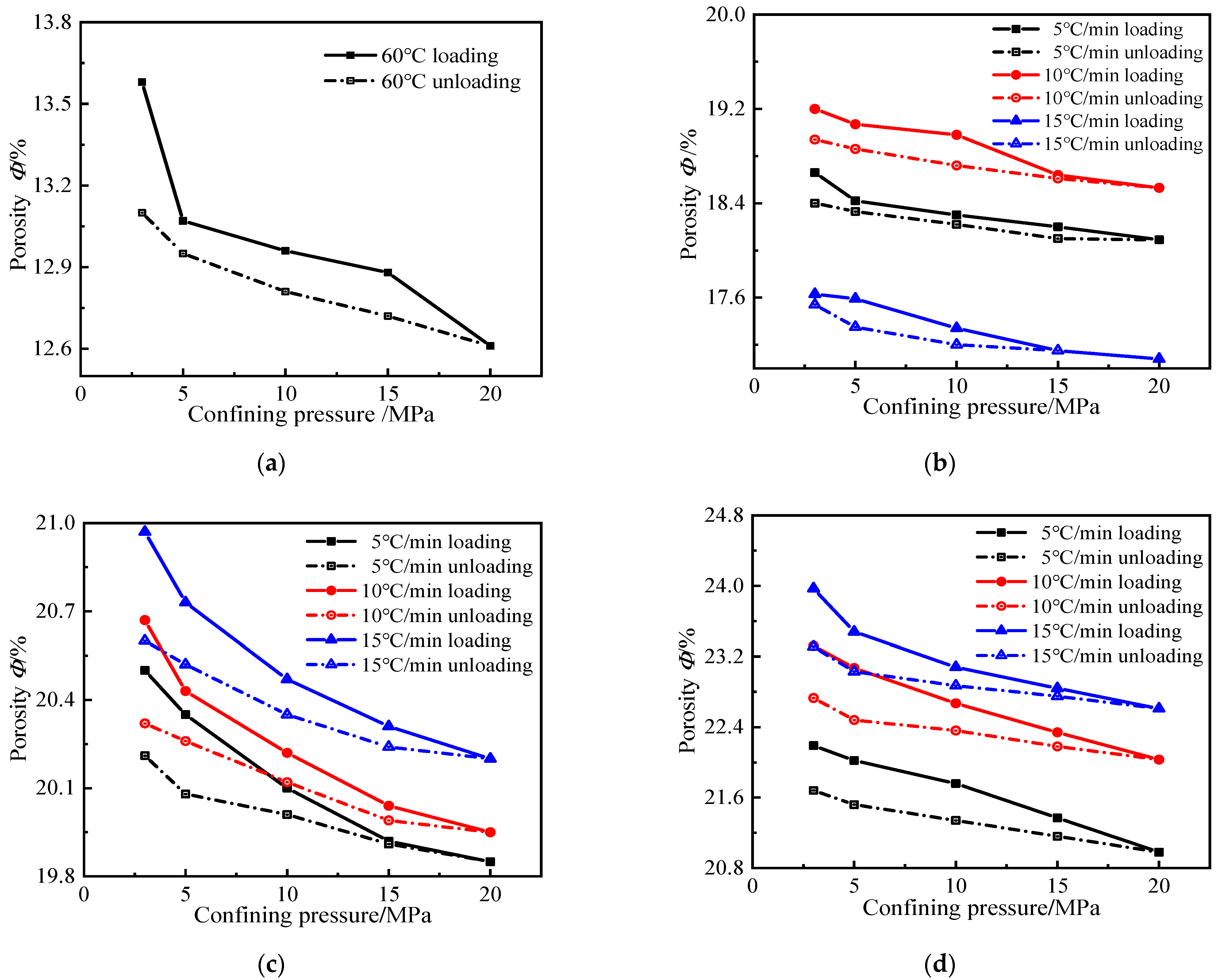
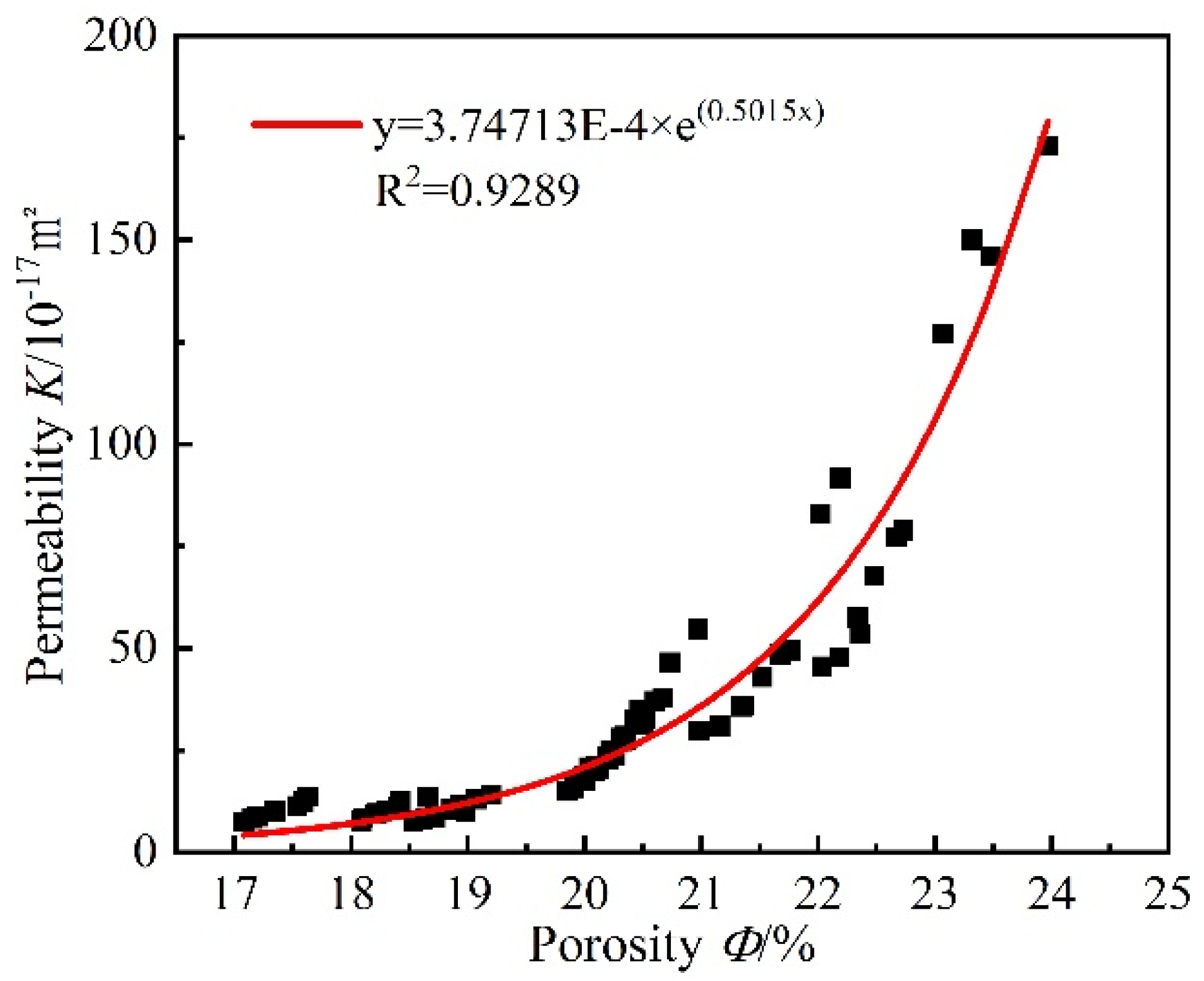
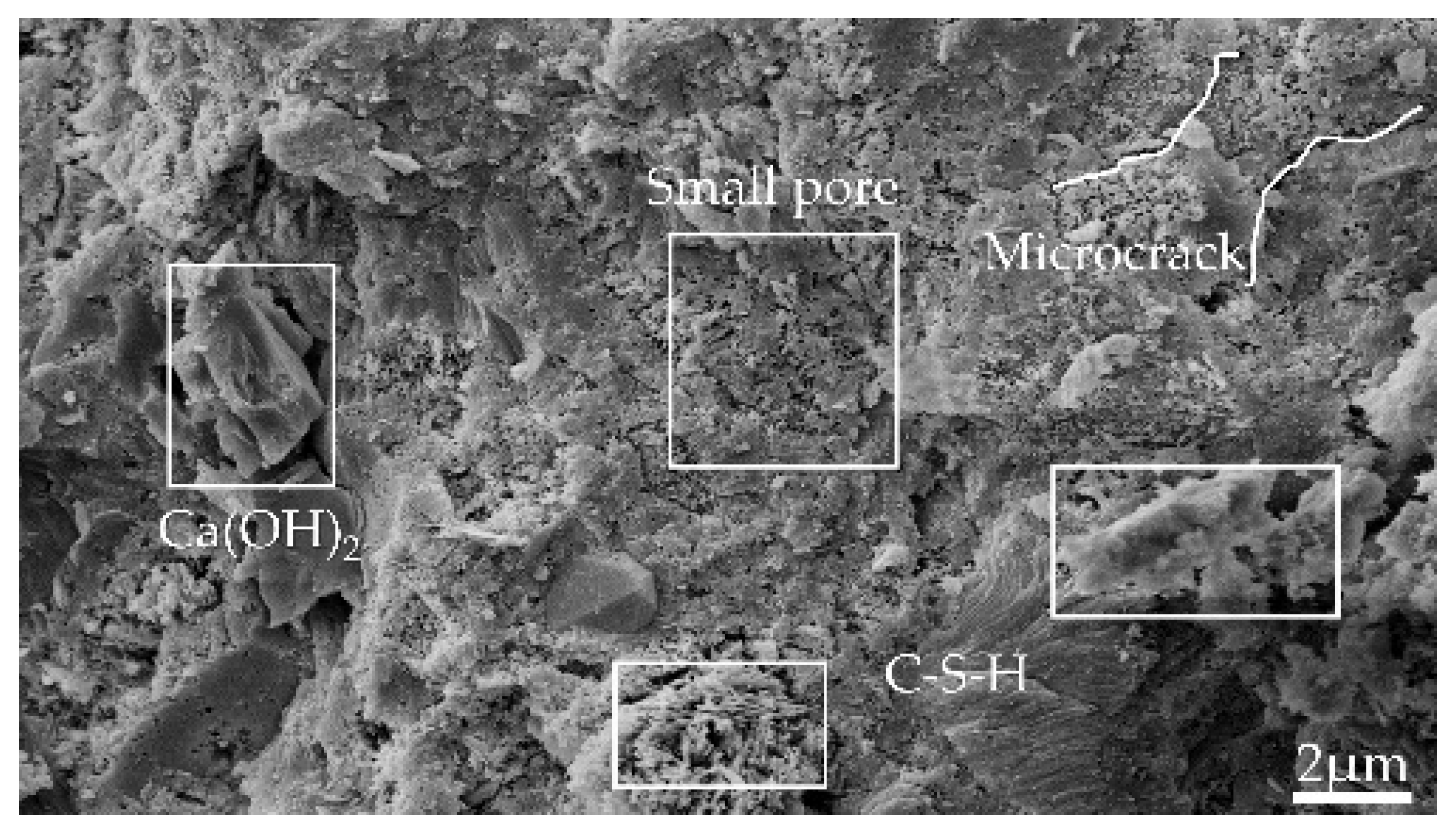



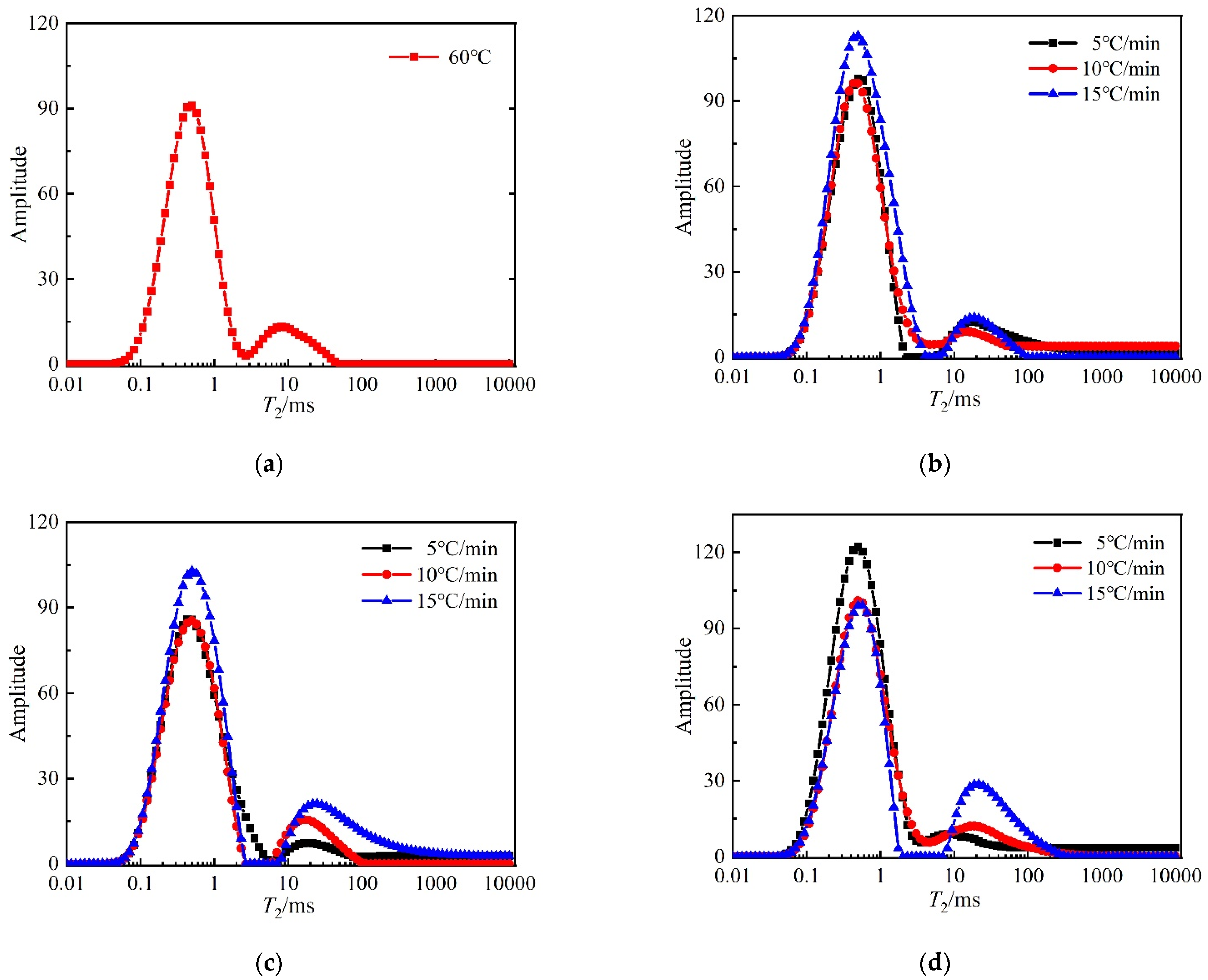

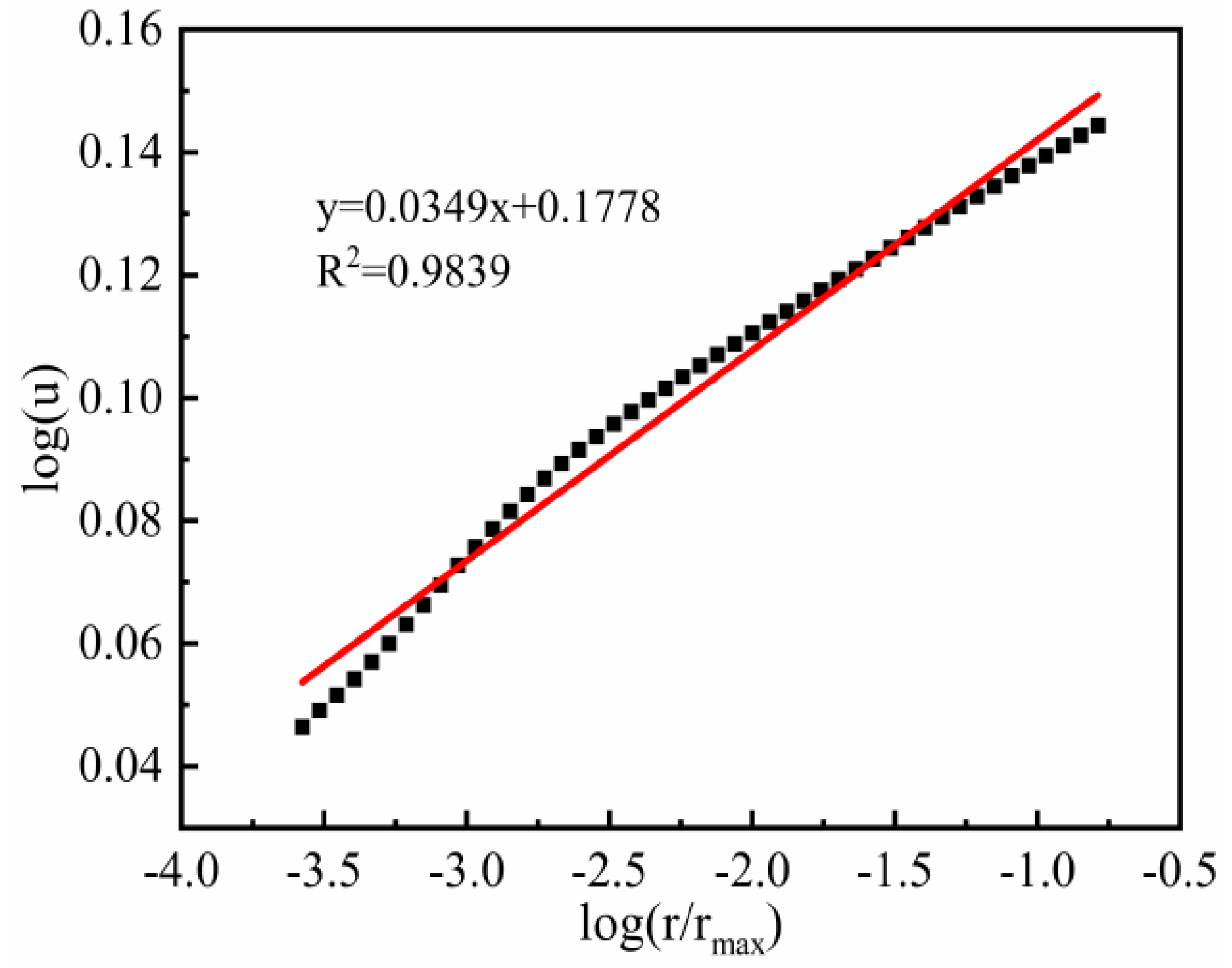
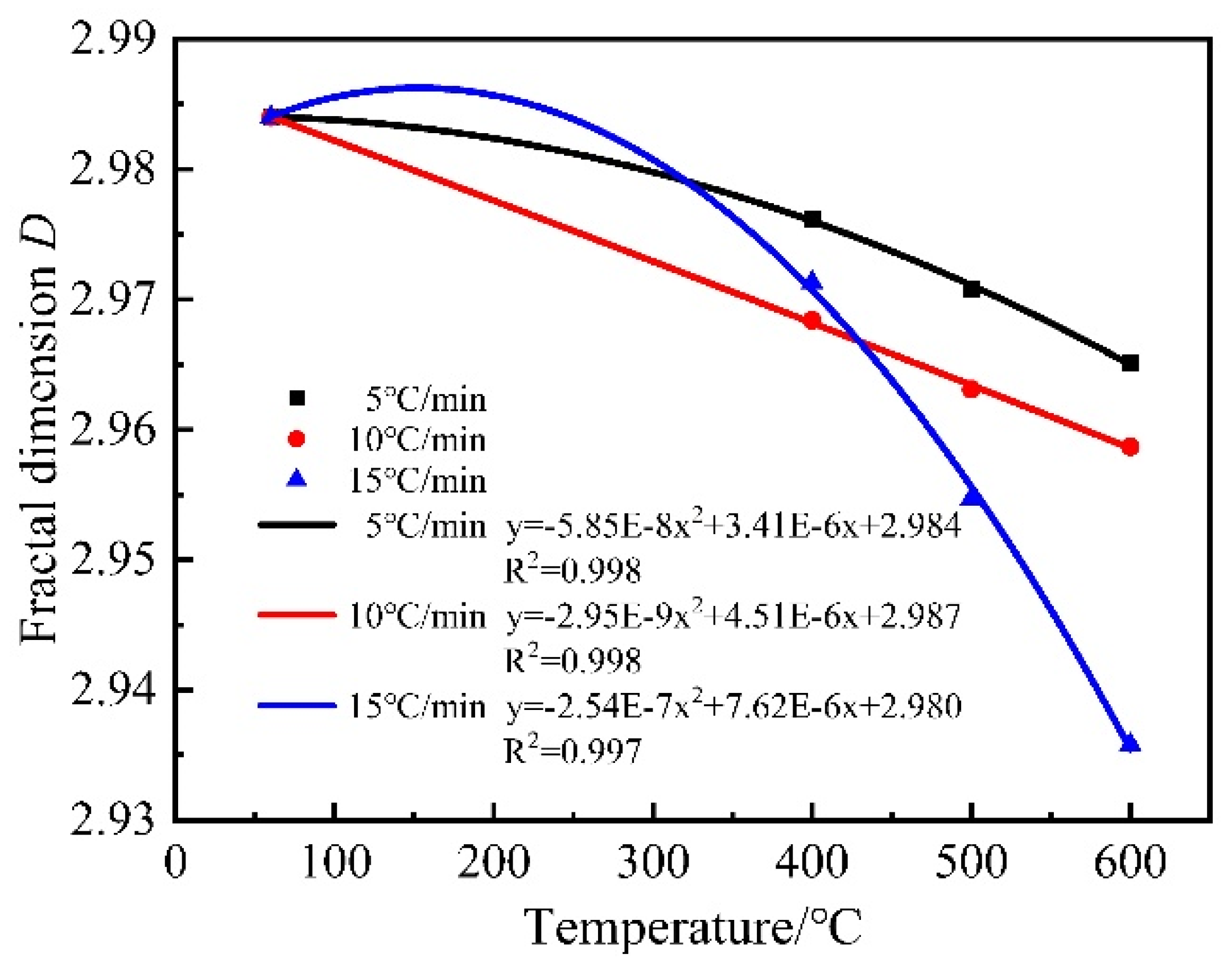
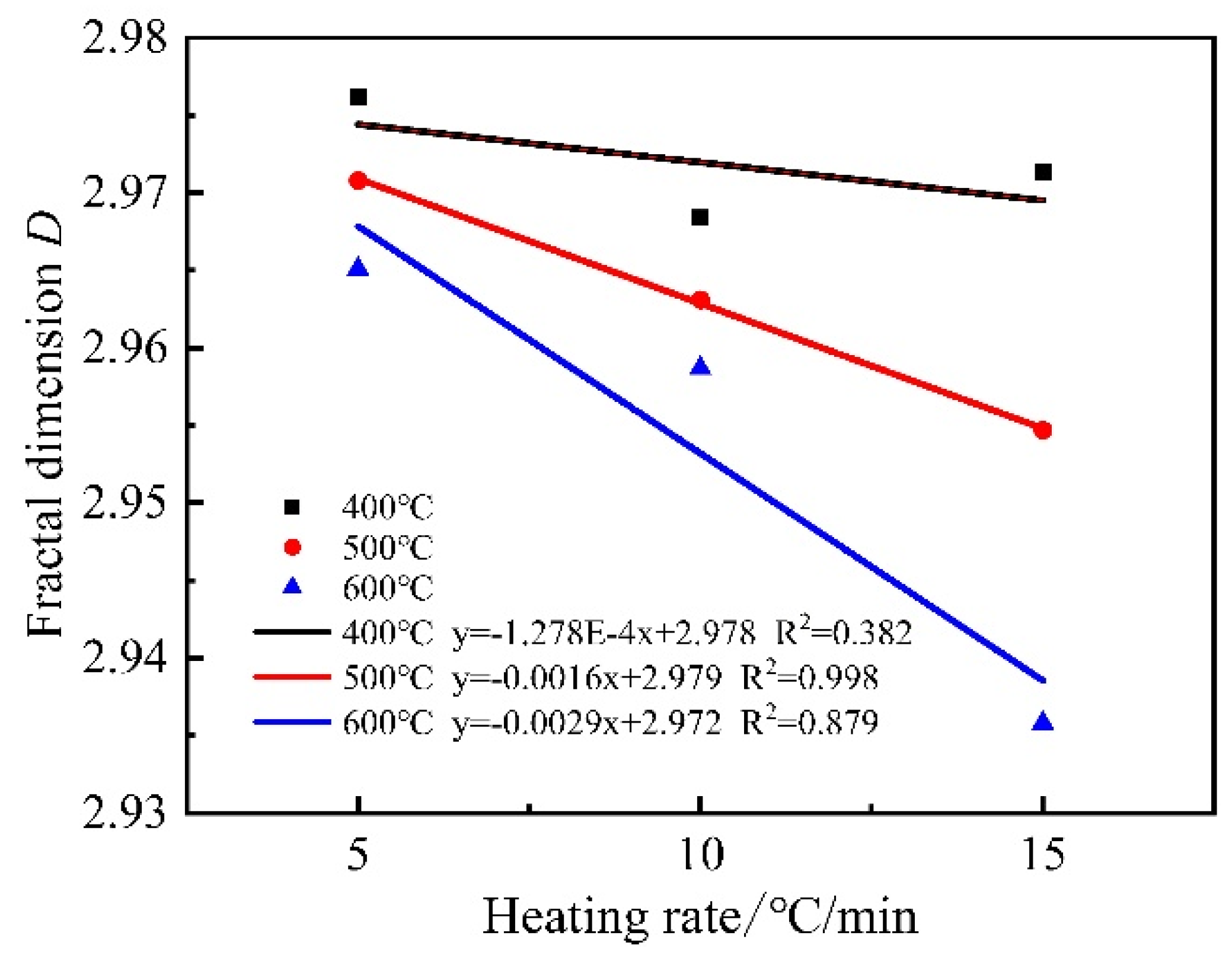
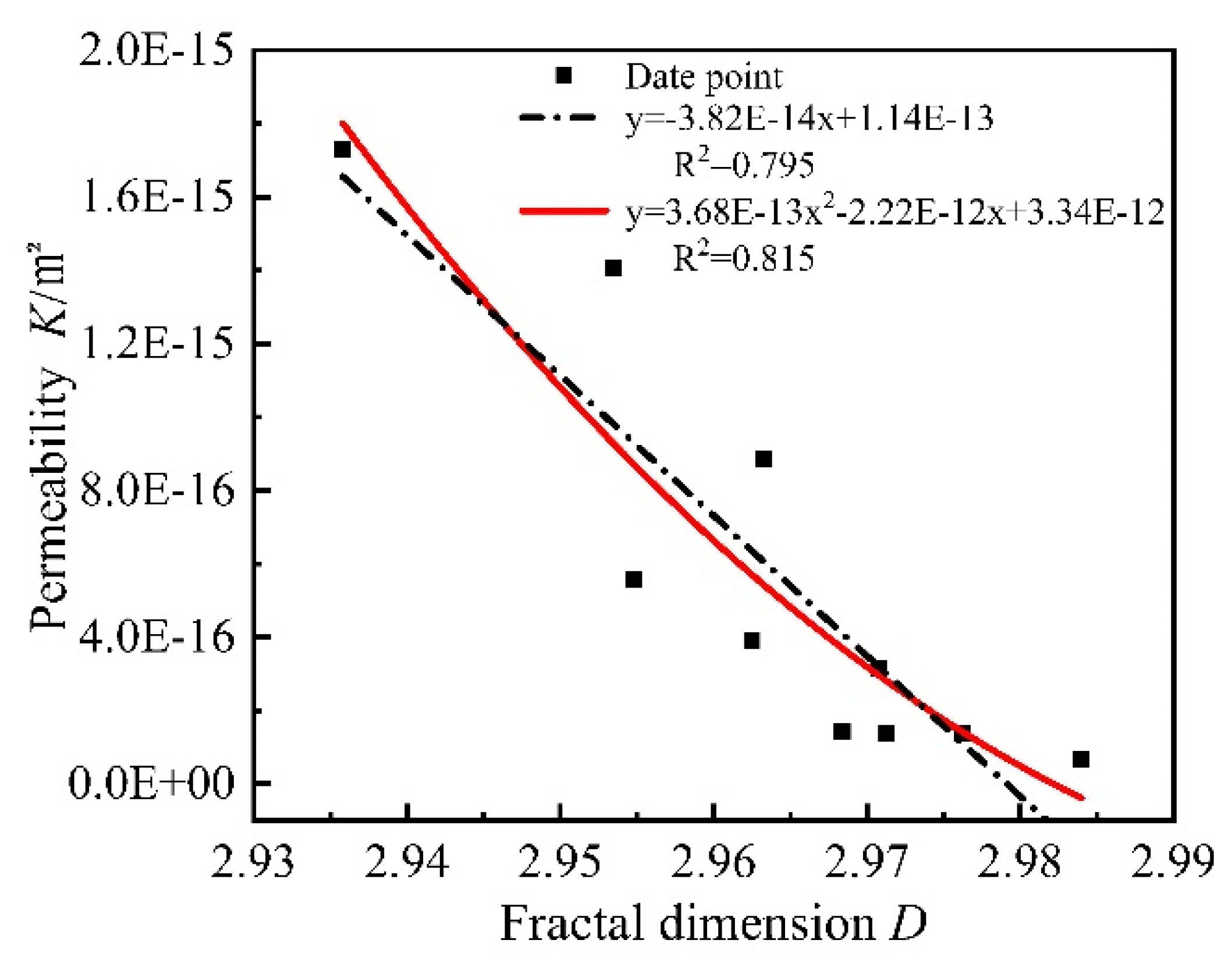
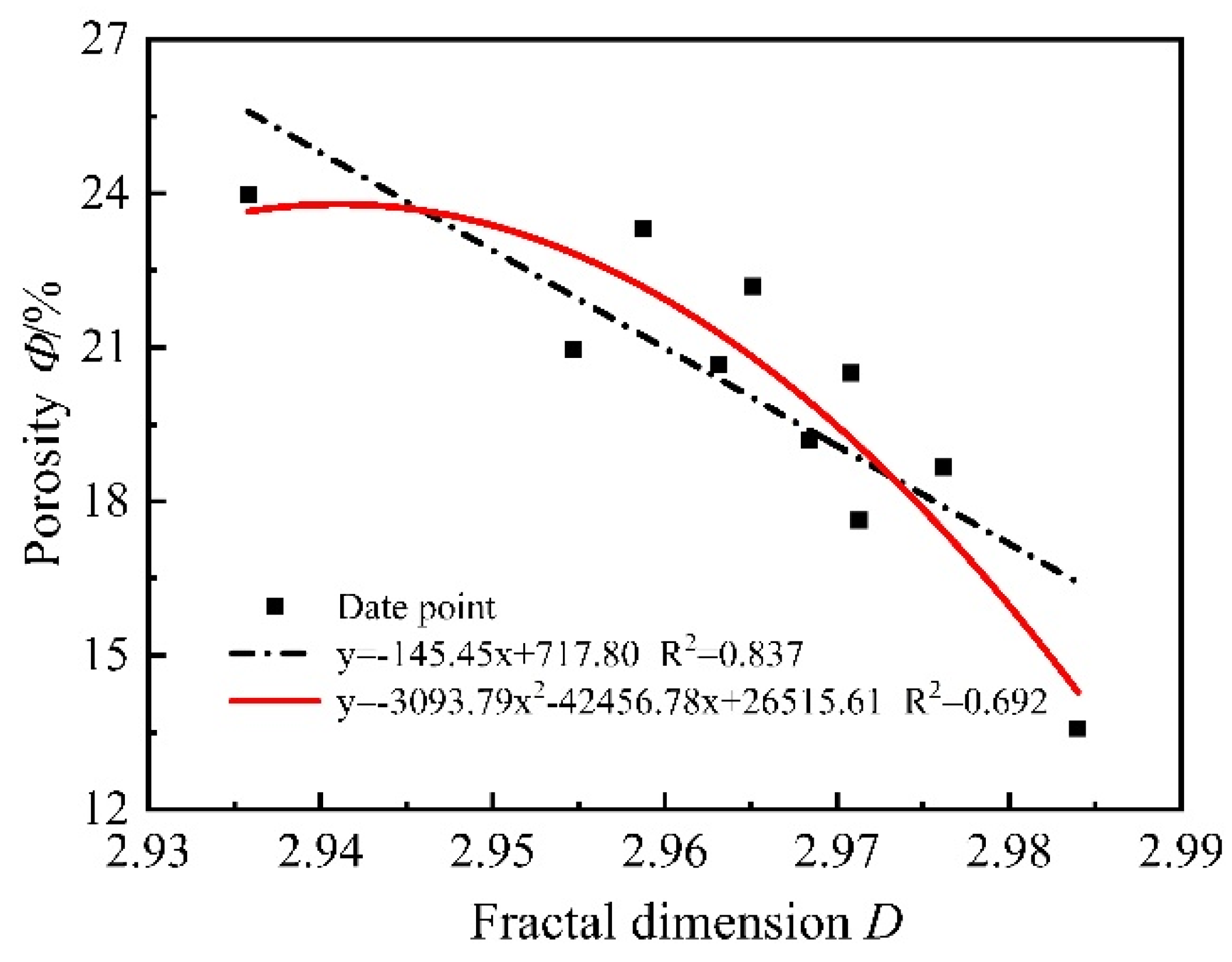
| W/C | Cement (kg/m3) | Sand (kg/m3) | Water (kg/m3) |
|---|---|---|---|
| 0.5 | 450 | 1350 | 225 |
Publisher’s Note: MDPI stays neutral with regard to jurisdictional claims in published maps and institutional affiliations. |
© 2022 by the authors. Licensee MDPI, Basel, Switzerland. This article is an open access article distributed under the terms and conditions of the Creative Commons Attribution (CC BY) license (https://creativecommons.org/licenses/by/4.0/).
Share and Cite
Chen, W.; Liu, Y.; Sheng, M.; Zhang, H.; Liang, Y.; Skoczylas, F. Heating Rate Effect on Gas Permeability and Pore Structure of Mortar under High Temperature. Materials 2022, 15, 6505. https://doi.org/10.3390/ma15196505
Chen W, Liu Y, Sheng M, Zhang H, Liang Y, Skoczylas F. Heating Rate Effect on Gas Permeability and Pore Structure of Mortar under High Temperature. Materials. 2022; 15(19):6505. https://doi.org/10.3390/ma15196505
Chicago/Turabian StyleChen, Wei, Yuehan Liu, Mingquan Sheng, Hejun Zhang, Yue Liang, and Frederic Skoczylas. 2022. "Heating Rate Effect on Gas Permeability and Pore Structure of Mortar under High Temperature" Materials 15, no. 19: 6505. https://doi.org/10.3390/ma15196505





